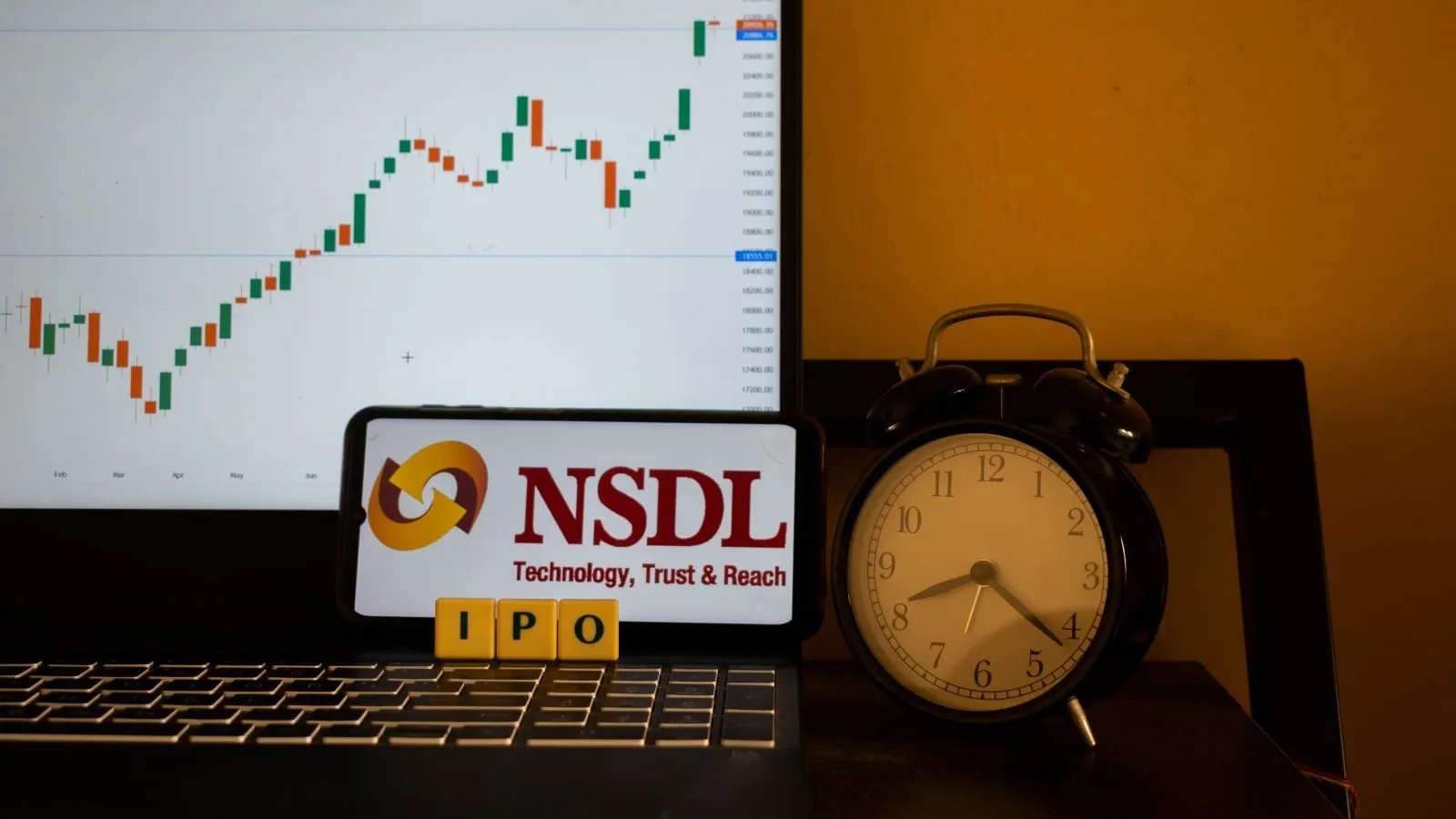Market News
NSDL vs CDSL: Which depository leads on revenue, market share and growth ahead of NSDL IPO?

6 min read | Updated on July 30, 2025, 00:12 IST
SUMMARY
The NSDL IPO will open for subscription on July 30. The depository service provider plans to raise ₹4,011.6 crore, which will be a complete offer-for-sale. As NSDL prepares to enter the public markets, here’s a comparative look at how it stacks up against its listed peer CDSL across key metrics such as revenue, profitability, asset quality, and distribution scale.

CDSL leads with total number of demat accounts at 15.3 crore compared to NSDL’s 3.95 crore.
As NSDL prepares for its mega IPO, investors' attention has turned to India’s highly concentrated securities depository market, dominated by NSDL and Central Depository Services Limited (CDSL).
India’s depository evolution: From paper to digital trust
India’s capital market infrastructure has transformed radically since the 1990s. Before 1996, investors grappled with physical share certificates and lengthy settlement periods. The Depositories Act, 1996 led to NSDL’s launch, followed by CDSL in 1999. Over time, settlement cycles shrank from T+5 rolling settlement and uniform settlement cycle to T+1 settlement cycle, and Aadhaar-based e-KYC now allows for instant online account opening. SEBI's 2024 beta version launch of T+0 settlements places India among the world’s most advanced capital markets.
Between FY17 and FY25, India’s depository market witnessed a CAGR of ~27.4% in client accounts and 22.4% in depository income. As of FY25, total standalone income stood at ₹17.16 billion and is projected to grow at 11–12% CAGR to ₹21–₹22 billion by FY27. NSDL and CDSL collectively manage over 190 million demat accounts, providing the digital backbone for India’s growing investor base.
How do NSDL and CDSL earn revenue?
| Revenue stream | Description |
|---|---|
| Transaction charges | Based on trades (market and off-market) |
| Custody fees | Annual charges on assets under custody |
| Account maintenance | Flat or asset-value linked fees for demat accounts |
| Issuer services | Charges for e-voting, KYC, corporate actions, etc. |
| Value-added services | Services like tokenisation, e-voting, KYC registration, etc. |
Financial scorecard: FY25 comparison
| Metric (₹ crore) | NSDL | CDSL |
|---|---|---|
| Revenue | ₹1,420.15 | ₹1,082.21 |
| PAT | ₹343.12 | ₹526.33 |
| EBITDA | ₹492.94 | ₹743.99 |
| PAT Margin (%) | 22.35% | 48.63% |
| ROE (%) | 17.11% | 29.90% |
| Net Worth | ₹2,005.34 | ₹1,760.35 |
In FY25, NSDL revenue stood at ₹1,420.15 crore, higher than CDSL’s ₹1,082.21 crore, indicating strong topline performance by NSDL. However, when it comes to profitability, CDSL outperformed significantly. CDSL reported a profit after tax (PAT) of ₹526.33 crore, much higher than NSDL’s ₹343.12 crore, despite the latter generating more revenue. CDSL PAT margin of 48.6% is more than double compared to NSDL highlighting superior operational efficiency and cost management.
Revenue mix: FY25 breakdown
| Revenue component | NSDL (%) | CDSL (%) |
|---|---|---|
| Annual/Custody fees | 34.50% | 33.11% |
| Transaction charges | 49.46% | 51.60% |
| Other income | 16.05% | 15.29% |
While both NSDL and CDSL derive a significant share from transaction charges, NSDL maintains a marginally higher share of stable, recurring income from annual and custody fees.
Key operational metrics
| Metric (FY25 in crore) | NSDL | CDSL |
|---|---|---|
| Total demat accounts | 3.95 | 15.30 |
| Individual & HUF accounts | 3.93 | 15.29 |
| Non-Individual accounts | .0018 | .0010 |
| Demat custody value | ₹4,64,16,404 | ₹70,52,402 |
| Avg. custody value per demat account (Nos) | 1.18 | 0.05 |
| Total quantity of securities held in demat | 4,75,869 | 83,599 |
| DP service centres (Nos) | 65,391 | 18,918 |
CDSL leads in account volumes with total number of demat accounts at 15.3 crore compared to NSDL’s 3.95 crore, largely driven by higher retail and HUF participation. However, NSDL holds a significantly higher demat custody value at ₹4,64,16,404 crore versus CDSL’s ₹70,52,402 crore, indicating its stronger institutional client base.
Market share highlights
| Metric | NSDL | CDSL |
|---|---|---|
| Share of demat accounts | 20.50% | 79.49% |
| Share of custody value | 86.81% | 13.19% |
| Transaction revenue per account | ₹91.69 | ₹33.21 |
| Share in number of unlisted companies (equity) registered | 73.04% | 26.96% |
| Value of shares settled in demat form | 66.03% | 33.97% |
| Market share in total active Instruments | 65.27% | 34.73% |
Despite holding only 20.5% of total demat accounts, NSDL commands a dominant 86.81% share in demant custody value, reflecting its strong institutional client base. Meanwhile, CDSL holds 79.49% of demat accounts but has only 13.1% share in demant custody value, indicating its retail-heavy portfolio. NSDL also earns nearly three times more transaction revenue per account (₹91.69 vs ₹33.21 per account). Furthermore, NSDL leads in key metrics such as unlisted company registrations (73.04%) and market share in active instruments (65.27%).
Client profile: Retail vs institutional
| Client Type (FY25) | NSDL | CDSL |
|---|---|---|
| Depository participants | 294 | 574 |
| Issuers (Nos) | 79,773 | 35,922 |
| New investor accounts (cr) | 0.37 | 3.77 |
| Non-resident & institutional accounts (cr) | 0.11 | 0.023 |
Strategic takeaways for investors
NSDL brings long-term institutional depth and higher-value assets under custody, while CDSL thrives on retail expansion. NSDL’s 100% OFS IPO provides no fresh capital, whereas CDSL, listed since 2017, has shown consistent performance. With both players operating regulated duopolies with strong cash flows, understanding their strategic differences helps identify which suits your investment horizon and style.
Final word
NSDL and CDSL, while operating in the same regulatory space, serve different market needs—NSDL has strong hold with institutional clients and value-driven metrics, and CDSL with its retail scale and margin efficiency. As NSDL goes public via a ₹4,011.6 crore OFS, investors now have the full landscape of India’s depository market in view. As Indian financial inclusion accelerates and capital markets matures further NSDL and CDSL are likely to be key beneficiaries.
About The Author
Next Story


